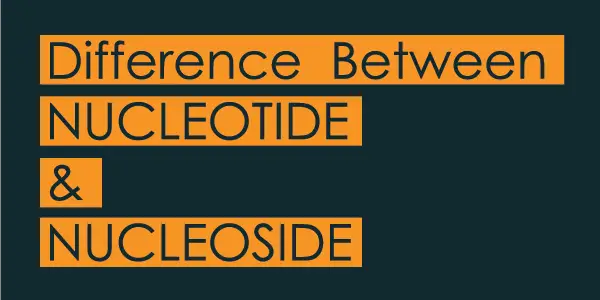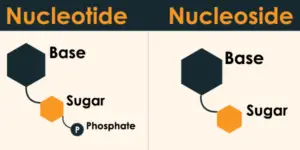
Difference between Nucleotide and Nucleoside
The key difference between Nucleotide and Nucleoside lies in their chemical compositions. A nucleotide is made of sugar, phosphate group, and a nitrogenous base WHILE a nucleoside is made of only one sugar and a base. Both these are building blocks of nucleic acids like DNA and RNA.

There are a total of 5 nitrogenous bases in nucleic acids (DNA & RNA). These 5 nitrogenous bases are Adenine, Thymine, Cytosine, Uracil, and Guanine. DNA possesses ATGC (adenine, thymine, guanine, cytosine) While RNA possesses AUGC and here simply Uracil is replaced by Thymine.
Difference between Nucleotide and Nucleoside iside-by-side:
| Nucleotide | Nucleoside | |
| 1. | It possesses a phosphate group. | It does not have a phosphate group in it. |
| 2. | It results in agents that cause cancer. | These are used as agents that fight cancer and viruses. |
| 3. | It gets covalently attached to other nucleotides to form a DNA or RNA strand. | It carries the process of phosphorylation for nucleotides. |
| 4. | These are 5’ Uridine monophosphate, 5’ Adenosine monophosphate, 5’ Guanosine monophosphate, 5’ Thymidine monophosphate, 5’ Cytidine monophosphate. | These are the same as Nucleotide but without 5’monophosphate. |
Also read: difference between cell and tissue
Function of Nucleotide :
Function of Nucleotide: It is an organic molecule that serve as the precursor of RNA & DNA. It can be considered as a basic unit of hereditary material. A nucleotide can also be a base molecule in ATP that serves as an energy house for the cell. It can also found in coenzymes as NADP & NAD.
another molecule that incorporates a Nucleotide is cyclic AMP (cAMP), a messenger molecule that is critical in lots of processes inclusive of the metabolism and transportation of chemical impulses to cells. nucleotides are not only limited to the building block of life, however, also shape many unique molecules that are known to make life viable.
You may also enjoy reading: